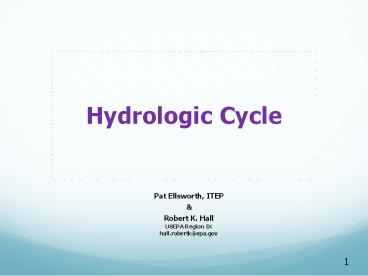Hydrologic Cycle - PowerPoint PPT Presentation
1 / 13
Title: Hydrologic Cycle
1
Hydrologic Cycle
- Pat Ellsworth, ITEP
- Robert K. Hall
- USEPA Region IX
- hall.robertk_at_epa.gov
2
Hydrologic Cycle
- Hydrologic cyclecirculation and conservation
of earth's water - Begins with evaporation of water from earth (20)
and ocean (80) surface - As moist air rises, it cools, and water vapor
condenses to form clouds - Moisture is transported around globe via oceanic
gyres (N and S hemispheres) until it returns
to surface as precipitation
3
Hydrologic Cycle (cont.)
- Once water reaches the ground
- Evaporates back into atmosphere
- Runs off into streams and lakes, eventually back
to ocean - Penetrates surface, becomes groundwater
- Groundwater will
- Seep into lakes, rivers, streams
- Return to atmosphere through transpiration
4
Earths Water Budget
(0.001)
(2.4)
(97.5)
Diagram adapted from Peixoto and Kettani (1973).
http//ww2010.atmos.uiuc.edu/(Gh)/guides/mtr/hyd/h
ome.rxml
5
Transport
Condensation
Condensation
Evaporation 20 (inland water and vegetation)
(rain, hail, sleet, snow, freezing rain)
Evaporation 10
Convection
Surface Layer
Zone of Aeration
Ground water flow
Zone of Saturation
Evaporation 80
Adapted from The Hydrologic Cycle. Illustration
by Tom Schultz
6
Hyporheic Zone
- Region beneath and lateral/adjacent to stream bed
- Mixing of shallow groundwater and surface water
- Hyporheic flow is important for
- Surface water/groundwater interactions
- Fish spawning
- Benthic macroinvertebrate distribution and
community structure
7
Hyporheic Zone (cont.)
RHEIC ZONE
Hyporheic Flow
Adapted from National park Service
(http//www.nps.gov/archive/sitk/Natural20Resour
ces/Stream20Ecology/Stream/hyporheic.htm)
8
Ecological Function
- Natural riparian-wetland areas characterized by
interactions of vegetation, soils, hydrology - Riparian-wetland areas function properly with
adequate vegetation, landform, or large woody
debris - Dissipates stream energy associated with high
waterflows - Reduces erosion, improves water quality.
- Changes in ecological function result from
alterations (e.g., fire, invasive species,
anthropogenic activity)
9
Ecological Function (cont.)
- Human influences accelerate changes in ecosystem
character - Over time, ecosystems develop spatial patterns
characteristic of human disturbance and
alterations - Necessary to recognize
- Different geographic patterns and
- How they respond to alterations and
resource-management activities
10
Illustration by Tom Schultz www.buffer.forestry.ia
state.edu/Photogallery/...
11
Riparian Function
Functional
Nonfunctional
Functional at Risk
12
Impacts Watershed Morphology and Invasive
Species Classification Humboldt River, NV
Area shown is part of the Special Recreation
Management Area Near Elko, NV Source BLM Nevada
State Office and BAE Systems Advanced
Technologies Inc.
13
Conclusion
- Hydrologic Cycle
- Impacts to the Hydrologic Cycle
- Preservation
- Tribal-oriented Best Management Practices (BMPs)
to achieve ecological function































